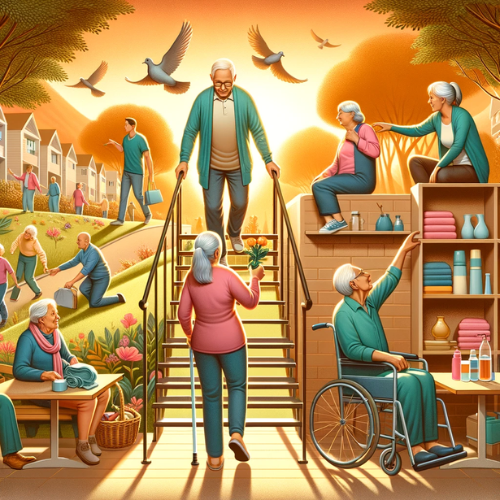Introduction to Elderly Mobility and Why It Matters
Mobility, or the ability to move freely and easily, is crucial for individuals of all ages, but it holds particular significance for the elderly. It’s a cornerstone of independence, impacting the quality of life and overall well-being. As we age, changes in physical health, including the decline of muscle strength, joint flexibility, and balance, can significantly affect mobility. This article delves into the concept of mobility within the context of elderly care, underscoring its importance for health and independence. By understanding and addressing the factors that impair mobility, seniors can maintain and even improve their ability to move freely, contributing to a more fulfilling and autonomous life.
Understanding the Concept of Mobility in the Context of Elderly Care
Mobility in elderly care encompasses more than the simple act of movement; it includes the range of physical activities from walking and climbing stairs to reaching for and grasping objects. Declines in these abilities can lead to increased dependency, which in turn can affect mental health, leading to feelings of isolation and depression. Recognizing the common factors that affect mobility, such as arthritis, osteoporosis, and neurological conditions, is the first step towards maintaining independence. Enhanced mobility not only contributes to physical health, such as improved circulation and reduced risk of chronic diseases, but also bolsters social interaction and engagement, essential components of a healthy life.
Assessment and Individualized Strategies for Mobility Enhancement
The role of healthcare professionals is paramount in assessing mobility levels and devising personalized plans for enhancement. Through comprehensive assessments, practitioners can identify specific limitations and recommend targeted exercises that respect the elderly’s current ability levels while ensuring safety. Such plans might include a mix of strength training, balance exercises, and flexibility routines, tailored to each individual’s needs and capabilities.
Incorporating mobility aids and assistive devices can be a game-changer for many seniors, providing the necessary support to maintain independence. From walkers to grab bars in strategic locations around the home, these tools can significantly enhance mobility and prevent falls. Encouraging a consistent routine of exercise and activity helps cement these gains, leading to sustainable improvements in mobility.
Implementing Fall-Prevention Measures and Safety Tips at Home
Creating a safe home environment is essential for preventing falls, a common cause of reduced mobility in the elderly. Simple measures, such as securing rugs, installing handrails in bathrooms and staircases, and ensuring homes are well-lit, can make a significant difference in preventing accidents. Regularly reviewing the home for potential hazards and making necessary adjustments is a proactive approach to maintaining mobility.
Holistic Approaches and Community Support for Optimizing Elderly Mobility
Improving mobility in the elderly isn’t solely about physical exercises; it encompasses a comprehensive approach that involves nutritional support, social engagement, and the utilization of community resources. A balanced diet plays a critical role in maintaining muscle strength and joint health, directly impacting mobility. Foods rich in calcium, vitamin D, and omega-3 fatty acids are especially beneficial for bone health and reducing inflammation.
Community engagement and social support significantly contribute to an elderly individual’s motivation to stay active. Participating in group activities not only fosters social connections but also encourages regular physical activity, which is vital for maintaining mobility. Moreover, holistic therapies such as physiotherapy and occupational therapy offer tailored strategies to enhance daily functioning and mobility, focusing on both the physical and psychological aspects of well-being.
Organizations like the National Council on Aging (NCOA) are pivotal in providing resources and programs designed to support the mobility of older adults. NCOA’s Center for Healthy Aging connects community organizations with evidence-based programs that empower older adults to lead active and fulfilling lives. These programs include a variety of activities ranging from aerobic and muscle-strengthening exercises to balance and flexibility training, all tailored to meet the unique needs of seniors. Programs such as Active Choices, EnhanceFitness, and the AEA Arthritis Foundation Aquatic Program are specifically designed to improve strength, flexibility, balance, and overall mobility in a safe and supportive environment.
Additionally, NCOA offers resources for implementing fall-prevention measures in the home, crucial for avoiding injuries that could impair mobility. Simple changes like securing rugs, installing grab bars in the bathroom, and ensuring adequate lighting can significantly reduce the risk of falls. Local resources and organizations, accessible through NCOA, provide invaluable support for seniors seeking to improve their mobility and independence.
By adopting a holistic approach that includes physical activity, nutrition, social support, and the use of assistive devices and resources like those offered by NCOA, seniors can significantly enhance their mobility. This comprehensive strategy not only improves their physical health but also boosts their confidence and ability to engage in daily activities, contributing to a higher quality of life and independence.
For more information on the NCOA and its programs, visit their official website at NCOA.
Conclusion:
Improving and maintaining mobility in the elderly is a multifaceted challenge that requires a comprehensive strategy encompassing physical exercise, nutritional support, the use of assistive devices, and a safe living environment. By adopting a holistic approach and leveraging community resources, seniors can enjoy a higher quality of life, marked by greater independence and engagement. Empowering the elderly to maintain and enhance their mobility is not just about adding years to their life but adding life to their years.


This article on improving mobility in the elderly is a treasure trove of practical advice and exercises. The emphasis on maintaining independence and overall well-being is commendable. We all have elderly family members and it is important to know how to best help them. I need to share this as I know many elderly people in my family and my friends’ families.
Moriah,
I’m deeply touched by your kind words and thrilled to hear that you found the article on improving mobility in the elderly so valuable. It’s heartening to know that the practical advice and exercises resonated with you, emphasizing the crucial aspect of maintaining independence and overall well-being for our elders. Sharing this knowledge with your family and friends can indeed make a profound difference in the lives of many. It’s through thoughtful actions like yours that we can spread awareness and provide the support our elderly loved ones need to live their lives to the fullest. Thank you for being a part of this important conversation and for your commitment to making a positive impact. Your effort to share this information is greatly appreciated and will undoubtedly help many. Thank you so much, Gary
Great information, Gary. As a relatively active 74 year-old man, the advice given here is extremely valuable not only to the aged, but to caregivers as well. I will continue to check out your website for additional tips.
Thank you so much for your kind words, Dan! I’m thrilled to hear that you found the information valuable. It’s fantastic to know that the advice resonates not just with seniors but also with caregivers as well. Your ongoing support and feedback mean a lot to me, and I look forward to sharing more helpful tips and insights on my website.
Gary,
This website offers so many perspectives to folks in their golden years, that I’m sure many people, including myself, overlook, or don’t consider. Maybe more specifically your explanation as to how mobility for seniors helps maintain independence, which can mean everything. I can certainly see how losing independence can lead to the feeling of isolation and depression. I’m really glad you are helping folks, who are either getting to that age, or have parents or loved ones getting to that age, learn and understand what they can be doing to prevent falls or other injuries, and keep an active and healthy life style to add life to their years.
Mike
Mike,
Thank you so much for your thoughtful comment. It means a great deal to me to know that the information shared on this website is resonating with you and potentially others who find themselves or their loved ones navigating the golden years. Independence is indeed a cornerstone of well-being for seniors, and understanding the role of mobility in maintaining that independence is crucial. My goal is to shed light on the small, manageable steps we can all take to prevent falls, avoid injuries, and promote an active, healthy lifestyle that truly adds life to years. It’s heartening to hear that this message is helpful to you and, I hope, to many others in similar situations. Please continue to share your insights and experiences; together, we can make a significant difference in the lives of those we care about. Thanks again, Gary